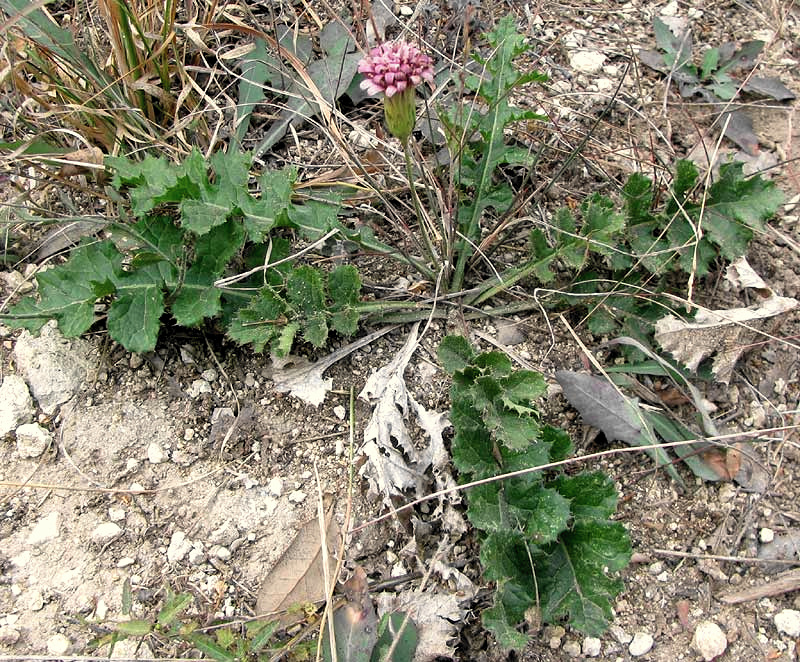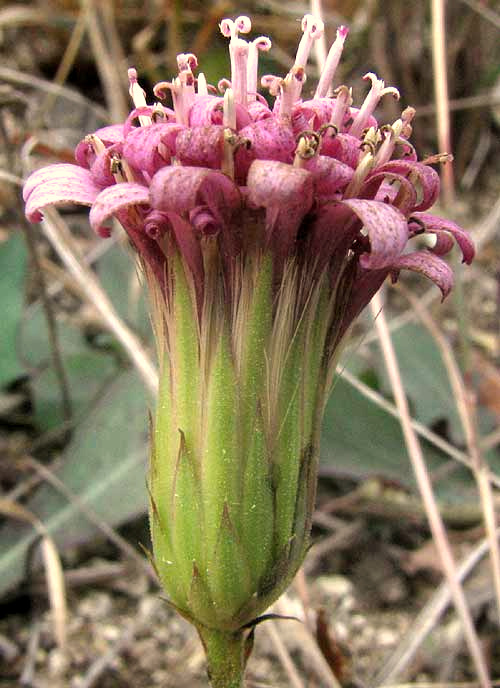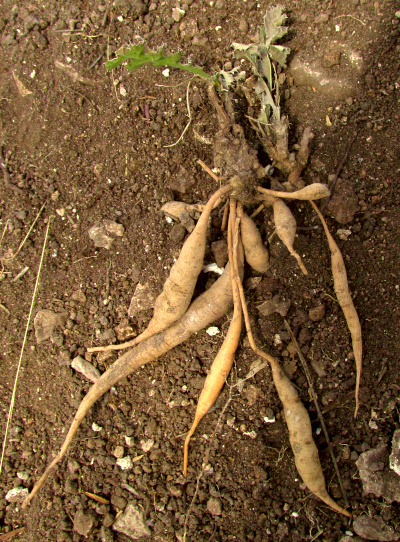Excerpts from Jim Conrad's
Naturalist Newsletter

from the December 2, 2012 Newsletter issued from the valley of the Dry Frio River in northern Uvalde County, southwestern Texas, on the southern border of the Edwards Plateau; elevation ~1750m (~5750 ft); N29.62°, W99.86°; USA
DESERT PEONY
The rush of fall wildflower blossomings is over now and few flowers are to be found. However, on thin soil atop limestone rock in a semi-open spot on a hill slope there's one ankle-high herblike perennial that catches the eye not only because it's producing a pinkish flower head when everything else has passed, but also because it's so unusual looking. Its growth form is like that of a Dandelion, with deeply pinnately lobed leaves forming a ground-hugging rosette, and a single composite flower head arising on a slender, leafless stem from the rosette's center. However, the leaf margins are sharply toothed, or
"spinulose-dentate," as botanists say, like a thistle's. You can see the whole thing above.
Its 5/8ths inch tall (15mm) flower head is shown below:

If you're familiar with Composite-Family flower heads, in which there are either "disk" flowers with tubular corollas (like the Eupatoriums), or "ray" flowers with longish, flat corollas (like the Dandelion), or a mixture of the two types, with disk flowers composing the "eye" and ray flowers looking like petals on a regular flower (as in the sunflowers and asters), you'll recognize that this flower head is unusual. The head's individual flowers at first look like they're all flattish ray flowers, but up close you see that they are tubular disk flowers with one side expanded into a flat, curled, tongue-like limb. They're disk flowers trying to be ray flowers.
This unusual wildflower is sometimes called Featherleaf Desertpeony or just Desert Peony. It's ACOURTIA RUNCINATA. Mainly it's a Mexican plant, found on limestone soils in much of Mexico's arid north, but it extends into the US here in Texas, in the central and southwestern regions. The genus Acourtia'a 41 known species occur only in warmer parts of North America, Mexico and Central America, and our Acourtia uncinata is the most widely distributed. I read that it's capable of flowering every month of the year, though its main blooming time is from March to August.
Desert Peopny's similarity to thistles seems to be incidental. Thistles belong to the Composite tribe Cynareae, while our Desert Peony is placed in the small, mostly tropical tribe Mutisieae. Northern gardeners might be familiar with the Gerbera Daisy, which resides in the Mutisieae.
issued August 28, 2021from the valley of the Dry Frio River in northern Uvalde County, southwestern Texas, on the southern border of the Edwards Plateau; elevation ~1750m (~5750 ft); N29.62°, W99.86°; USA
DESERT PEONY TUBERS
I was pick-axing a level spot into a slope scalped by the landowner about seven years ago, now covered with grass and a few pioneering native wildflowers and shrubs. I felt bad about digging things up, but that was my job, payment for a place to park my body awhile. What's shown below was unearthed:

The leaves appear to be that of the Brownfoot, and I can't think of any other wildflower in this area with such prickly-margined, deeply lobed leaves and not seeming interested in forming a stem. Flora of North America describes Acourtia runcinata as "...the most widespread species of the genus, within which it is unique in possessing fasciculate, tuberous-fusiform roots."
I find several references to the plant being medicinal, but there's no mention of how or what part of the plant is used.